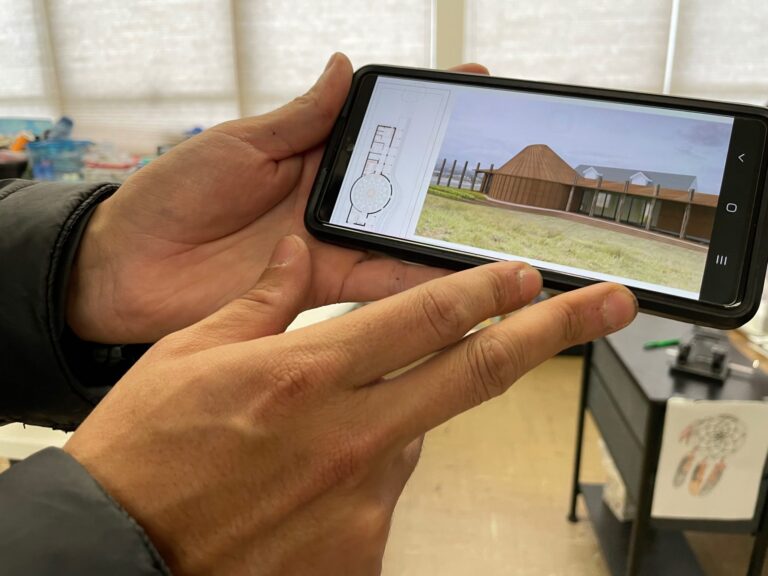Photo: Shelby Leung shows staff of the Roundhouse Council renderings for the nonprofit’s new building. (Jessica Terrell/Civil Beat/2023)
Wildfires destroyed most of Greenville, California, but the rebuilding process could be a turning point for the local Maidu tribe.
Standing in an elementary school classroom that serves as the temporary headquarters for the Roundhouse Council, Danny Manning and Shelby Leung flip through a cardboard box of donated children’s books, chuckling as they come across familiar favorites.
They shuffle through a history of California’s Indigenous communities. An old coloring book. A collection of Native American legends.
“Do you remember this one?” Manning asks, holding up an illustrated folk tale about the origin of a colorful flower in the Southwest.
For the last two years, staff from the Roundhouse Council, an Indian educational center in the remote mountain town of Greenville, California, have been collecting donations and scouring yard sales trying to replace the many books it lost in the Dixie Fire.
The 2021 blaze, fueled by a combination of intense winds and dry conditions similar to what Lahaina experienced on the day of its deadly fire in August, destroyed more than 75% of structures in Greenville, along with the Greenville Rancheria tribe’s health clinic, fire department, administrative headquarters and a museum that held irreplaceable Maidu heirlooms and cultural artifacts. The fire was so hot it cracked the stone mortars in the Roundhouse Council’s educational center.
“Some of the stuff was the only one we had that we could look at and see how to make another one,” Manning said, adding that his family had stored numerous heirlooms at the museum, thinking it was the safest place in town. “We lost (cultural) blueprints in that museum.”
Two years after the fire, Manning and Leung — both of whom work for the tribe’s fire department and are board members at the nonprofit Roundhouse Council — can still point to the loss that each vacant lot in town represents. But they also now have a clearer vision for the future.
The somber conversation in the classroom turns exuberant as Leung pulls out his phone to show two staff members the latest renderings for the new Roundhouse building under construction less than a block away. The large round room at the front of the building, which was designed to highlight the sun on the summer solstice, will host cultural classes and community gatherings. More importantly, it will be the first building in more than a century in Greenville to be constructed with traditional Maidu features.
“The old building was a house that was donated for Indian education,” Leung said. “So now we have a chance to build something that is really suitable for what it is used for.”
The fire destroyed much of what the local Maidu community had worked hard to build in the last 40 years. But the catastrophe may also prove a turning point for the Greenville tribe, which has struggled for generations to secure a future for its members in their ancestral home.
Five decades ago, there was no legally recognized tribe in Greenville. The Greenville Rancheria owned no land. Received no federal benefits. Had no organized government. No visible presence in a town best known for its connection to the gold rush, an event that decimated the Native American population in California.
Today, the Greenville Rancheria is playing a prominent role in rebuilding the town — and finding an unexpected groundswell of community support for its efforts to address past wrongs and create something new in the process.
“When this happened, it’s like even more people that weren’t Maidu or Native wanted to use this to try to build that up and support that,” Leung said.
Painful Parallels
Lahaina and Greenville are thousands of miles apart, but they have more in common than the shared pain of watching ferocious winds push an out-of-control blaze through a historic town.
Around the same time that American-owned sugar plantations were expanding their footprints and changing the course of Hawaii history, white settlers were setting out to […]
Full article: www.civilbeat.org

